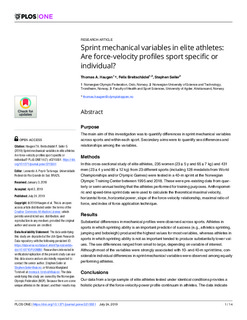| dc.contributor.author | Haugen, Thomas André | |
| dc.contributor.author | Breitschedel, Felix | |
| dc.contributor.author | Seiler, Stephen | |
| dc.date.accessioned | 2019-11-21T11:36:24Z | |
| dc.date.available | 2019-11-21T11:36:24Z | |
| dc.date.created | 2019-09-11T14:07:14Z | |
| dc.date.issued | 2019 | |
| dc.identifier.citation | PLOS ONE. 2019, 14 (7), . | nb_NO |
| dc.identifier.issn | 1932-6203 | |
| dc.identifier.uri | http://hdl.handle.net/11250/2629747 | |
| dc.description.abstract | Purpose
The main aim of this investigation was to quantify differences in sprint mechanical variables across sports and within each sport. Secondary aims were to quantify sex differences and relationships among the variables.
Methods
In this cross-sectional study of elite athletes, 235 women (23 ± 5 y and 65 ± 7 kg) and 431 men (23 ± 4 y and 80 ± 12 kg) from 23 different sports (including 128 medalists from World Championships and/or Olympic Games) were tested in a 40-m sprint at the Norwegian Olympic Training Center between 1995 and 2018. These were pre-existing data from quarterly or semi-annual testing that the athletes performed for training purposes. Anthropometric and speed-time sprint data were used to calculate the theoretical maximal velocity, horizontal force, horizontal power, slope of the force-velocity relationship, maximal ratio of force, and index of force application technique.
Results
Substantial differences in mechanical profiles were observed across sports. Athletes in sports in which sprinting ability is an important predictor of success (e.g., athletics sprinting, jumping and bobsleigh) produced the highest values for most variables, whereas athletes in sports in which sprinting ability is not as important tended to produce substantially lower values. The sex differences ranged from small to large, depending on variable of interest. Although most of the variables were strongly associated with 10- and 40-m sprint time, considerable individual differences in sprint mechanical variables were observed among equally performing athletes.
Conclusions
Our data from a large sample of elite athletes tested under identical conditions provides a holistic picture of the force-velocity-power profile continuum in athletes. The data indicate that sprint mechanical variables are more individual than sport specific. The values presented in this study could be used by coaches to develop interventions that optimize the training stimulus to the individual athlete. | nb_NO |
| dc.language.iso | eng | nb_NO |
| dc.publisher | Public Library of Science | nb_NO |
| dc.rights | Navngivelse 4.0 Internasjonal | * |
| dc.rights | Navngivelse 4.0 Internasjonal | * |
| dc.rights.uri | http://creativecommons.org/licenses/by/4.0/deed.no | * |
| dc.rights.uri | http://creativecommons.org/licenses/by/4.0/deed.no | * |
| dc.title | Sprint mechanical variables in elite athletes: Are force-velocity profiles sport specific or individual? | nb_NO |
| dc.type | Journal article | nb_NO |
| dc.type | Peer reviewed | nb_NO |
| dc.description.version | publishedVersion | nb_NO |
| dc.source.pagenumber | 14 | nb_NO |
| dc.source.volume | 14 | nb_NO |
| dc.source.journal | PLOS ONE | nb_NO |
| dc.source.issue | 7 | nb_NO |
| dc.identifier.doi | 10.1371/journal.pone.0215551 | |
| dc.identifier.cristin | 1723669 | |
| dc.description.localcode | © 2019 Haugen et al. This is an open access article distributed under the terms of the Creative Commons Attribution License, which permits unrestricted use, distribution, and reproduction in any medium, provided the original author and source are credited. | nb_NO |
| cristin.unitcode | 194,64,91,0 | |
| cristin.unitname | Institutt for bygg- og miljøteknikk | |
| cristin.ispublished | true | |
| cristin.fulltext | original | |
| cristin.qualitycode | 1 | |

